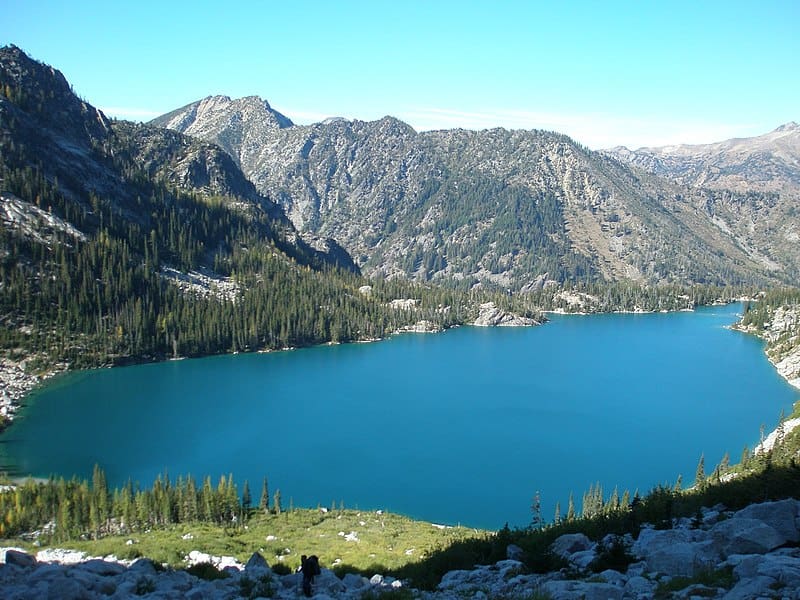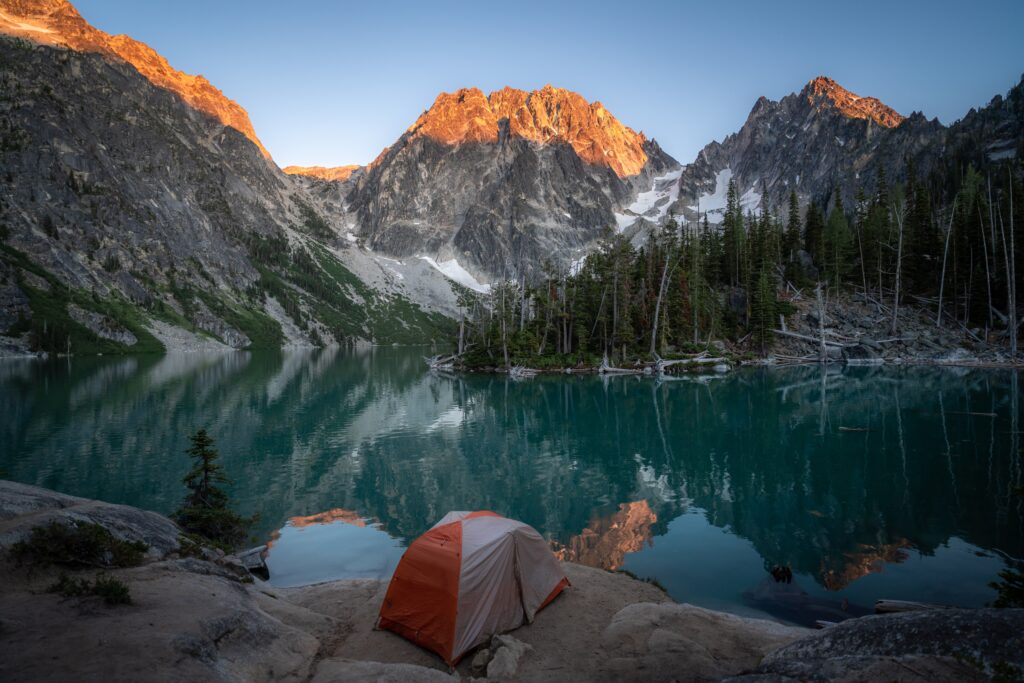The Colchuck Lake Trail is a popular route leading to Colchuck Lake. It’s a scenic alpine lake in the Central Cascades of Washington State. Granite cliffs, forests, and glaciers surround the lake. Colchuk Lake is named from the Chinook word for “cold waters.” Let’s explore the history of this lake and its surroundings.
History
The Enchantments area, home to Colchuck Lake, has a fascinating geological past. In the 1940s, numerous dams were built on several lakes, including Colchuck, Eightmile, Lower Klonaqua, Square, Upper Snow, Lower Snow, and Nada. The Icicle and Peshastin Irrigation Districts now manage Colchuck Lake, a water storage facility for irrigation purposes. The Colchuck Lake Trailhead was established in 1967 to make the lake accessible.

The size of Colchuck Lake is 0.7 miles at its longest point and 0.3 miles at its widest point.
©X-Weinzar/ CC0 2.0 – License
Size
Colchuck Lake is more significant than the nearby Enchantment Lakes, showcasing similar stunning views. This mesmerizing lake is beneath Dragontail Peak and Colchuck Peak, two of the tallest mountains in Washington.
At its longest point, the lake spans 0.7 miles. It’s 0.3 miles at its widest point. Its maximum depth measures 120 feet. Hikers and backpackers love visiting the lake because of the view of the rocky cliffs and dense forests. The Colchuck Lake trail is steep and rugged if you’re up for a challenge. It’s a 4-mile hike that you can access from the Stuart Lake Trailhead—an elevation rise of 2,300 feet. The moderate-rated trail is a round trip of 9 miles, and hikers can expect to gain 2,100 feet of elevation.
Depth
Not only is Colchuck Lake large, but it is also deep, with a maximum depth of 190 feet (58 meters). Depending on the lake’s depth, its surface elevation may range from 5,574 feet above sea level. On average, the lake can store up to 1,570 acre-feet of water. The distance from the top of the concrete pedestal to the depth of the gate is approximately 16 feet or 4.9 meters. A cement masonry dam was built in the late 1930s to contain the lake, and there is a spillway at the dam’s center to manage overflow. The lake is in a basin characterized by rocky soils and igneous tonalite geology.

The elevation of Colchuck Lake is 2,300 feet for hiking enthusiasts.
©Own work/CC BY-SA 4.0 – License
Water Level
The hike to this gorgeous lake is challenging, with an overall elevation gain of 2,300 feet. Hikers have ample time to admire the creek on the way during the first 1.5 miles of the hike, which is relatively easy and flat.
The final ascent to the lake is steep and rough in places, but the spectacular scenery makes it all worth it. Hikers and backpackers often visit the turquoise waters of Colchuck Lake. While the water level of Colchuck Lake can vary depending on the season and weather, it remains a must-see destination for anyone visiting the Pacific Northwest. The unique beauty of Colchuck Lake is an unforgettable experience that everyone should have the opportunity to enjoy.
Fishing
Colchuck Lake is home to various fish. These include cutthroat trout, rainbow trout, and brook trout. You can find fish in the lake’s shallower areas, especially near the inlet stream or outlet creek. Various fish species in the nearby streams are great for fly fishing. The lake is also a well-liked spot for fishing, with ample shoreline and boat space for anglers. This means there is plenty of room for everyone wanting a fun and successful fishing trip. The lake’s fish population is healthy and abundant, making it an excellent spot for anglers of all levels.
Popular fishing techniques for this lake include spinners, spoons, and flies. Spinners like Rooster Tails and spoons such as Luhr Jensen Krocodiles, Dardevles, or Kastmasters can effectively attract fish. Fly fishing is also a popular method, especially for targeting cutthroat trout. When fishing at Colchuck Lake, hiking in with your gear is essential, as the lake is accessible only via the Colchuck Lake Trail.
Geology
The lake is in a geological formation known as a “cirque,” a bowl-shaped basin surrounded by high cliffs at the summit of a glacier valley. The main type of rock in the area is the Mount Stuart batholith, a considerable amount of igneous rock that is under the Stuart Range and the nearby Wenatchee Mountains.
The rocks in the batholith vary in composition from two-pyroxene gabbro to granite and are from the Late Cretaceous period. The uplift of the Mount Stuart batholith occurred several times, followed by periods of erosion. This geological history has shaped the stunning landscape of the lake and the surrounding Enchantments region, characterized by polished granite cliffs, soaring peaks, and pristine alpine lakes.
Boating and Other Activities
Boating is prohibited at Colchuck Lake because of its location within the Enchantment Permit Area. The lake’s isolated location and the requirement to hike through the Colchuck Lake Trail make it unsuitable for boating activities. However, visitors can enjoy various other recreational activities around the lake.
Hiking is a popular activity at this particular lake, with the Colchuck Lake Trail offering stunning views of Colchuck peaks and Dragontail and access to other popular hiking trails in the area. The trail is eight miles round trip and is moderately complex, making it suitable for hikers with some experience. Besides hiking, trail running is another popular activity for those exploring the area on foot.
Photography enthusiasts will find plenty of opportunities to capture the breathtaking scenery around Colchuck Lake, including the polished granite cliffs, the surrounding peaks, and the pristine alpine waters. Wildlife sightings are also possible, with deer, marmots, and pikas often spotted in the area.
While Colchuck Lake does not allow boating, visitors can still enjoy its serene beauty by simply relaxing on its shores, taking in the stunning views, and enjoying a picnic. Reserving the Enchantments region by practicing Leave No Trace and removing all trash is essential.

Camping at Colchuck Lake in the Enchantments, Okanogan-Wenatchee National Forest.
©Cavan-Images/Shutterstock.com
Camping
The stunning Colchuck Lake is in central Washington, an alpine paradise. Here are some things to keep in mind if you plan to camp at Colchuck Lake:
Camping in the Enchantments Core (at Colchuck Lake) requires a permit, as it is in the backcountry. These permits are in high demand but limited in number. You can obtain them through a lottery system or walk-up permits if available.
Overnight camping in this area requires a permit from May 15 – October 31. See Enchantment Lakes permit information.
Camping at this lake requires some planning, so planning and making reservations early is recommended.
The campsites around the lake are primitive and lack amenities. Visitors must pack in and pack out all their gear and trash.
Storing food and disposing of waste properly is critical to avoiding wildlife in this area.
Camping at Colchuck Lake is a unique and unforgettable experience for outdoor enthusiasts. This place is perfect for disconnecting from the chaos of the world. Thanks to its panoramic views and tranquil atmosphere, you can immerse yourself in nature.
Conclusion
Colchuck Lake is a breathtaking destination for outdoor enthusiasts to check out at least once in their lifetime. Colchuck Lake is a must-visit location for anyone exploring the Central Cascades in Washington State, with its stunning scenery, diverse activities, and opportunities for fishing and camping. You can experience the beauty of nature and make memories all at the same time. We can’t overstate the importance of respecting the environment and leaving no trace when visiting this place. By following the guidelines for backcountry camping and observing proper wildlife safety, you can enjoy the splendor of Colchuck Lake and contribute to its preservation.
The photo featured at the top of this post is © Own work/CC BY-SA 4.0 – License / Original
Thank you for reading! Have some feedback for us? Contact the AZ Animals editorial team.







